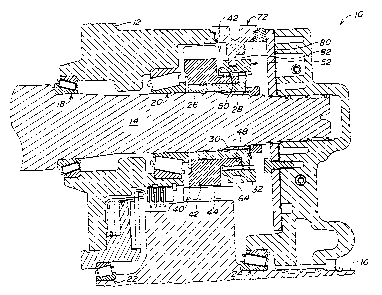Some of the information on this Web page has been provided by external sources. The Government of Canada is not responsible for the accuracy, reliability or currency of the information supplied by external sources. Users wishing to rely upon this information should consult directly with the source of the information. Content provided by external sources is not subject to official languages, privacy and accessibility requirements.
Any discrepancies in the text and image of the Claims and Abstract are due to differing posting times. Text of the Claims and Abstract are posted:
| (12) Patent: | (11) CA 2436002 |
|---|---|
| (54) English Title: | TORQUE DISCONNECT MECHANISM |
| (54) French Title: | MECANISME DE DEBRAYAGE |
| Status: | Expired and beyond the Period of Reversal |
| (51) International Patent Classification (IPC): |
|
|---|---|
| (72) Inventors : |
|
| (73) Owners : |
|
| (71) Applicants : |
|
| (74) Agent: | BORDEN LADNER GERVAIS LLP |
| (74) Associate agent: | |
| (45) Issued: | 2007-07-10 |
| (22) Filed Date: | 2003-07-25 |
| (41) Open to Public Inspection: | 2004-02-12 |
| Examination requested: | 2003-07-25 |
| Availability of licence: | N/A |
| Dedicated to the Public: | N/A |
| (25) Language of filing: | English |
| Patent Cooperation Treaty (PCT): | No |
|---|
| (30) Application Priority Data: | ||||||
|---|---|---|---|---|---|---|
|
A torque disconnect mechanism controls transmission of torque from a first
shaft to a second shaft in a transmission. The mechanism includes a housing
which
rotatably supports the first and second shafts, and which has an opening
formed
therein. A coupling member is movable from an engaged position wherein the
coupling member couples the first shaft with the second shaft to a disengaged
position wherein the first and second shafts are uncoupled from each other. A
plug
member is mountable in the opening and is engagable with the coupling member.
The plug member is movable from a first position holding the coupling member
in its
engaged position to a second position holding the coupling member in its
disengaged position.
Note: Claims are shown in the official language in which they were submitted.
Note: Descriptions are shown in the official language in which they were submitted.

2024-08-01:As part of the Next Generation Patents (NGP) transition, the Canadian Patents Database (CPD) now contains a more detailed Event History, which replicates the Event Log of our new back-office solution.
Please note that "Inactive:" events refers to events no longer in use in our new back-office solution.
For a clearer understanding of the status of the application/patent presented on this page, the site Disclaimer , as well as the definitions for Patent , Event History , Maintenance Fee and Payment History should be consulted.
| Description | Date |
|---|---|
| Inactive: IPC deactivated | 2016-03-12 |
| Inactive: First IPC assigned | 2016-01-08 |
| Inactive: IPC assigned | 2016-01-08 |
| Inactive: IPC expired | 2012-01-01 |
| Time Limit for Reversal Expired | 2008-07-25 |
| Letter Sent | 2007-07-25 |
| Grant by Issuance | 2007-07-10 |
| Inactive: Cover page published | 2007-07-09 |
| Pre-grant | 2007-04-17 |
| Inactive: Final fee received | 2007-04-17 |
| Notice of Allowance is Issued | 2006-10-19 |
| Letter Sent | 2006-10-19 |
| Notice of Allowance is Issued | 2006-10-19 |
| Inactive: IPC removed | 2006-08-30 |
| Inactive: IPC removed | 2006-08-30 |
| Inactive: IPC assigned | 2006-08-30 |
| Inactive: Approved for allowance (AFA) | 2006-08-21 |
| Amendment Received - Voluntary Amendment | 2006-07-13 |
| Inactive: IPC from MCD | 2006-03-12 |
| Inactive: IPC from MCD | 2006-03-12 |
| Inactive: IPC from MCD | 2006-03-12 |
| Inactive: S.29 Rules - Examiner requisition | 2006-01-17 |
| Inactive: S.30(2) Rules - Examiner requisition | 2006-01-17 |
| Application Published (Open to Public Inspection) | 2004-02-12 |
| Inactive: Cover page published | 2004-02-11 |
| Inactive: First IPC assigned | 2003-09-30 |
| Inactive: Filing certificate - RFE (English) | 2003-09-02 |
| Filing Requirements Determined Compliant | 2003-09-02 |
| Letter Sent | 2003-09-02 |
| Letter Sent | 2003-09-02 |
| Application Received - Regular National | 2003-09-02 |
| Request for Examination Requirements Determined Compliant | 2003-07-25 |
| All Requirements for Examination Determined Compliant | 2003-07-25 |
There is no abandonment history.
The last payment was received on 2006-07-13
Note : If the full payment has not been received on or before the date indicated, a further fee may be required which may be one of the following
Please refer to the CIPO Patent Fees web page to see all current fee amounts.
| Fee Type | Anniversary Year | Due Date | Paid Date |
|---|---|---|---|
| Registration of a document | 2003-07-25 | ||
| Application fee - standard | 2003-07-25 | ||
| Request for examination - standard | 2003-07-25 | ||
| MF (application, 2nd anniv.) - standard | 02 | 2005-07-25 | 2005-07-06 |
| MF (application, 3rd anniv.) - standard | 03 | 2006-07-25 | 2006-07-13 |
| Final fee - standard | 2007-04-17 |
Note: Records showing the ownership history in alphabetical order.
| Current Owners on Record |
|---|
| DEERE & COMPANY |
| Past Owners on Record |
|---|
| JOHN C. GOGOLA |
| PAUL W. JOHNSON |
| THOMAS G. ORE |